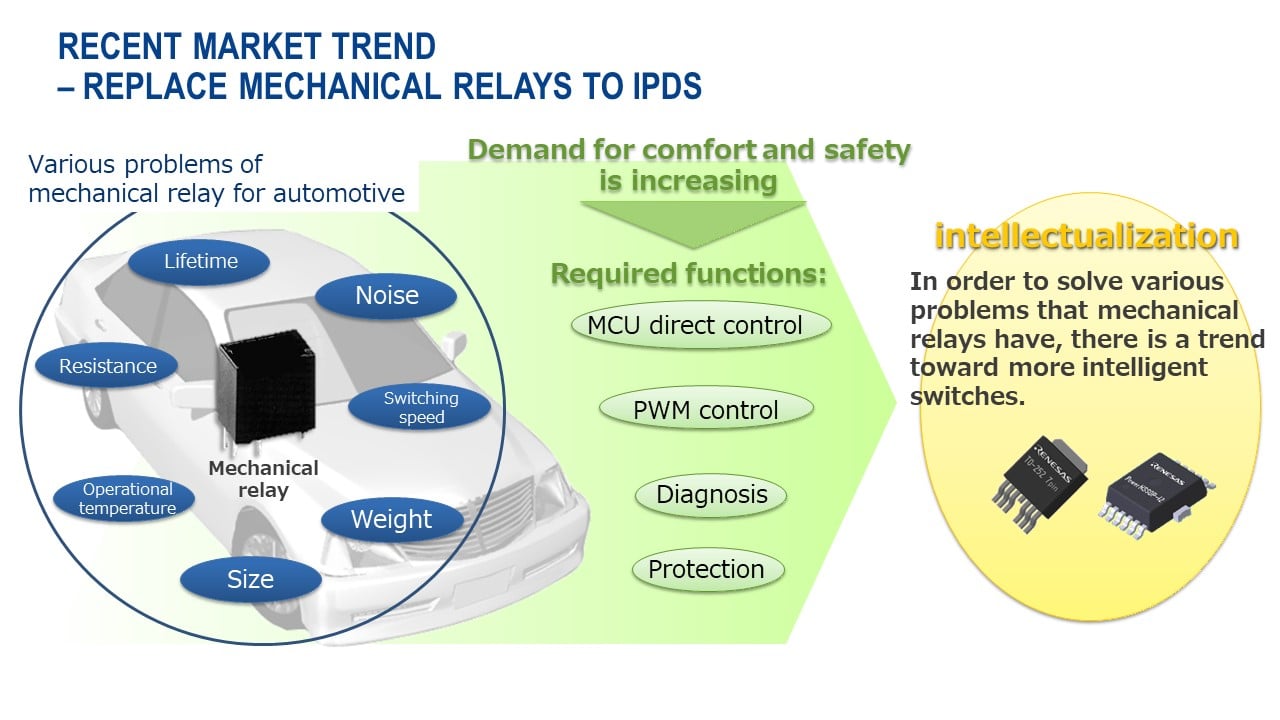With the shift to an E/E architecture in automobiles, communication and control networks in vehicles are undergoing a major transformation with the adoption of CAN and Gigabit Ethernet. To achieve a safer system, power distribution networks must be similarly transformed to become more hierarchical, redundant, and with protection features.
In conventional power distribution networks, fuses and mechanical relays are used to distribute and switch power. Recently, microcomputer-based power control is being used to achieve more detailed control of power distribution and safety functions, and fuses and mechanical relays are also being replaced with semiconductor switches. Renesas has made a contribution to the innovation of power distribution networks in automobiles by offering an intelligent power device (IPD) that is integrated with semiconductor switches and various protection/diagnostic circuits in a single package, which is more durable than conventional fuses and mechanical relays.
Conventional fuses and mechanical relays have durability, quietness, and component size and weight issues compared with semiconductor switches.
Fuses protect from short-circuit and over-current problems by blowing out and cutting off the power supply to the connected circuits. In addition, mechanical relays are operated by electromagnets to supply power through physical contact between movable and fixed contacts, thus mechanical durability as well as electrical durability should be considered. With these characteristics, fuses and mechanical relays need to be replaced on more frequent cycles. For this reason, these components were installed in a fuse/relay box in the engine room and under the passenger's feet for ease of maintenance.
Wire harnesses were thicker and heavier, as fuses and mechanical relays located at the front of the vehicle supplied power to the entire vehicle.

As semiconductor switches such as our IPDs are more durable than conventional fuses and mechanical relays and do not require frequent replacement, it allows the placing of an ECU with an MCU and IPD close to the load in an E/E architecture, thus contributing to the optimization of the wire diameter and weight reduction of the harness.
In addition, Renesas' IPD has a protection/diagnostic function that detects overcurrent, overvoltage, and overheating, and can safely control the output of the IPD and notify the MCU that controls the IPD in case of a problem such as a load short circuit or harness damage.
The IPD notifies the MCU of the detection by the protection/diagnostic circuitry, enabling the microcomputer to control the load while keeping the output in a safe range and alerting the driver for an early inspection at the dealership. The IPD realizes the safe vehicle system that cannot be achieved with conventional fuses, which immediately shut down the output.
In recent automobiles, many switches are used. There are many circuits that supply the power even when the ignition is turned off (lights, door locks, etc.), and it is also important to consider the power during standby since the battery supplies power to maintain the vehicle system when the engine is not in use. Renesas' IPDs are designed with the concept of low power consumption in standby conditions, so battery consumption can be kept low even when many IPDs are used in a hierarchical power network in the E/E architecture.
Renesas offers a lineup of microcontrollers, power management ICs (PMICs), and IPDs that are key components of automotive ECUs in the E/E architecture, as well as various solutions that combine these key components.
Visit our Automotive Protected and Intelligent Power Devices page to discover Renesas' IPD products and solutions that are contributing to building a more secure power distribution network.
